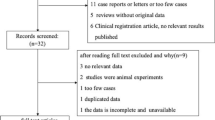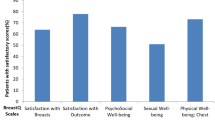Abstract
Objective
Synthetic meshes and acellular dermal matrices are increasingly used in implant-based breast reconstruction. The objective of this study was to determine the incidence and severity of complications following the implantation of the partially absorbable bi-component soft mesh SERAGYN® BR and assess risk factors for adverse operative outcomes.
Methods
A retrospective clinical study was performed: The SERAGYN® BR soft mesh was utilized in 148 operations (skin-sparing mastectomy, nipple-sparing mastectomy, breast-conserving surgery, and secondary reconstruction after mastectomy) in four different institutions in Germany from June 2012 to February 2014. We analyzed whether the results were affected by tumor morphology (e.g., grading), patient characteristics and comorbidities, previous surgery or therapies, and use of alloplastic materials.
Results
The SERAGYN® BR soft mesh was successfully implanted in 131 of 148 operations. The rate of reconstructive failure was 11.5%. The most common complication was seroma (25.7%), followed by hematoma and skin infection (each 14.2%). Wound-healing issues were detected in 13.5% cases, secondary wound infections in 10.8%. 83.8% of operations had no severe complications. Independent predictors for reconstructive failure were wound-healing issues, nipple- or skin necrosis, wound- or skin infections, a high volume of excised tissue, hematomas, seromas, and sentinel lymph node excisions. A higher body mass index was correlated with a higher rate of infection.
Conclusion
SERAGYN® BR mesh can be used successfully in breast reconstructive surgery. Rates of major complications or reconstructive failure are comparable to the use of other synthetic or biological meshes.
Similar content being viewed by others
Abbreviations
- DIEP:
-
Deep inferior epigastric perforators
- ADM:
-
Acellular dermal matrix
- TRAM:
-
Transverse rectus abdominis muscle
- GCP:
-
Good clinical practice
- SLNE:
-
Sentinel lymph node excision
- LNE:
-
Lymph node excision
References
Leitlinie S Mammakarzinom der Frau; Diagnostik, Therapie und Nachsorge; http://www.awmf.org/leitlinien/detail/ll/032-045OL.html. Accessed 16 Apr 2017
Uroskie TW, Colen LB (2004) History of breast reconstruction. Semin Plast Surg 18(2):65–69. https://doi.org/10.1055/s-2004-829040
Marsh D, Patel NG, Rozen WM, Chowdhry MR, Sharma H, Ramakrishnan VV (2016) Three routine free flaps per day in a single operating theatre: principles of a process mapping approach to improving surgical efficiency. Gland Surg 5(2):107–114. https://doi.org/10.3978/j.issn.2227-684x.2015.07.04
Leitlinie Brustrekonstruktion mit Eigengewebe der German Society of Gynecology and obstetrics in cooperation with AWMF (Arbeitsgemeinschaften der wissenschaftlichen medizinischen Fachgesellschaften e.v.), S Leitlinie Stand 05/2015
Albornoz CR, Bach PB, Mehrara BJ, Disa JJ, Pusic AL, McCarthy CM, Cordeiro PG, Matros E (2013) A paradigm shift in US breast reconstruction: increasing implant rates. Plast Reconstr Surg 131(1):15–23. https://doi.org/10.1097/prs.0b013e3182729cde
Gerber B, Krause A, Dieterich M, Kundt G, Reimer T (2009) The oncological safety of skin sparing mastectomy with conservation of the nipple-areola complex and autologous reconstruction: an extended follow-up study. Ann Surg 249(3):461–468. https://doi.org/10.1097/sla.0b013e31819a044f
Dieterich M, Faridi A (2013) Biological matrices and synthetic meshes used in implant based breast reconstruction—a review of products available in Germany. Geburtshilfe Frauenheilkd 73(11):1100–1106. https://doi.org/10.1055/s-0033-1350930
Ellis HL, Asaolu O, Nebo V, Abdul Kasem A (2016) Biological and synthetic mesh use in breast reconstructive surgery: a literature review. World J Surg Oncol. https://doi.org/10.1186/s12957-016-0874-9 Published online 2016 Apr 21
Newman MI, Swartz KA, Samson MC, Mahoney CB, Diab K (2011) The true incidence of near-term postoperative complications in prosthetic breast reconstruction utilizing human acellular dermal matrices: a meta-analysis. Aesthetic Plast Surg 35(1):100–106. https://doi.org/10.1007/s00266-010-9631-6 Epub 2010 Dec 24
Dieterich M, Reimer T, Dieterich H, Stubert J, Gerber B (2012) A short-term follow-up of implant based breast reconstruction using a titanium-coated polypropylene mesh (TiLoop(®) Bra). Eur J Surg Oncol 38(12):1225–1230. https://doi.org/10.1016/j.ejso.2012.08.026 Epub 2012 Sep 13
Ho G, Nguyen TJ, Shahabi A, Hwang BH, Chan LS, Wong AK (2012) A systematic review and meta-analysis of complications associated with acellular dermal matrix-assisted breast reconstruction. Ann Plast Surg 68(4):346–356. https://doi.org/10.1097/sap.0b013e31823f3cd9
Dieterich M, Stubert J, Gerber B, Reimer T, Richter DU (2015) Biocompatibility, cell growth and clinical relevance of synthetic meshes and biological matrixes for internal support in implant-based breast reconstruction. Arch Gynecol Obstet 291(6):1371–1379. https://doi.org/10.1007/s00404-014-3578-9 Epub 2014 Dec 13
Serag-Wiessner: https://www.serag-wiessner.de/produkte/textile-implantate/seragyn-br/. Accessed 16 Apr 2017
Arbeitsgemeinschaft gynäkologische Onkologie: https://www.ago-online.de. Accessed 16 Apr 2017
Chun YS, Verma K, Rosen H et al (2010) Implant-based breast reconstruction using acellular dermal matrix and the risk of postoperative complications. Plast Reconstr Surg 125:429–436
Weichman KE, Wilson SC, Weinstein AL et al (2012) The use of acellular dermal matrix in immediate two-stage tissue expander breast reconstruction. Plast Reconstr Surg 129:1049–1058
Salzberg CA, Dunavant C, Nocera N (2012) Immediate breast reconstruction using porcine acellular dermal matrix (Strattice): long-term outcomes and complications. J Plast Reconstr Aesthet Surg 66:323–328
Peled AW, Foster RD, Garwood ER et al (2012) The effects of acellular dermal matrix in expander-implant breast reconstruction after total skin-sparing mastectomy: results of a prospective practice improvement study. Plast Reconstr Surg 129:901e–908e
Kim JY, Davila AA, Persing S, Connor CM, Jovanovic B, Khan SA, Fine N, Rawlani V (2012) A meta-analysis of human acellular dermis and submuscular tissue expander breast reconstruction. Plast Reconstr Surg 129(1):28–41. https://doi.org/10.1097/prs.0b013e3182361fd6
Ibrahim AM, Shuster M, Koolen PG, Kim K, Taghinia AH, Sinno HH, Lee BT, Lin SJ (2013) Analysis of the National Surgical Quality Improvement Program database in 19,100 patients undergoing implant-based breast reconstruction: complication rates with acellular dermal matrix. Plast Reconstr Surg 132(5):1057–1066. https://doi.org/10.1097/prs.0b013e3182a3beec
Dieterich M, Paepke S, Zwiefel K, Dieterich H, Blohmer J, Faridi A, Klein E, Gerber B, Nestle-Kraemling C (2013) Implant-based breast reconstruction using a titanium-coated polypropylene mesh (TiLOOP Bra): a multicenter study of 231 cases. Plast Reconstr Surg 132(1):8e–19e. https://doi.org/10.1097/prs.0b013e318290f8a0
Becker H, Lind JG (2013) The use of synthetic mesh in reconstructive, revision, and cosmetic breast surgery. Aesthet Plast Surg 37(5):914–921. https://doi.org/10.1007/s00266-013-0171-8 Published online 2013 Jul 17
ten Wolde B, van den Wildenberg FJ, Keemers-Gels ME, Polat F, Strobbe LJ (2014) Quilting prevents seroma formation following breast cancer surgery: closing the dead space by quilting prevents seroma following axillary lymph node dissection and mastectomy. Ann Surg Oncol 21(3):802–807. https://doi.org/10.1245/s10434-013-3359-x Epub 2013 Nov 12
Madsen RJ, Esmonde NO, Ramsey KL, Hansen JE (2015) Axillary Lymph Node Dissection Is a Risk Factor for Major Complications After Immediate Breast Reconstruction. Ann Plast Surg. https://doi.org/10.1097/sap.0000000000000653 [Epub ahead of print] PMID: 26545220
Chun YS, Verma K, Rosen H, Lipsitz S, Morris D, Kenney P, Eriksson E (2010) Implant-based breast reconstruction using acellular dermal matrix and the risk of postoperative complications. Plast Reconstr Surg 125(2):429–436. https://doi.org/10.1097/prs.0b013e3181c82d90
Ooi A, Song DH (2016) Reducing infection risk in implant-based breast-reconstruction surgery: challenges and solutions. Breast Cancer (Dove Med Press) 8:161–172. https://doi.org/10.2147/bctt.s97764
Lanier ST, Wang ED, Chen JJ, Arora BP, Katz SM, Gelfand MA, Khan SU, Dagum AB, Bui DT (2010) The effect of acellular dermal matrix use on complication rates in tissue expander/implant breast reconstruction. Ann Plast Surg 64(5):674–678. https://doi.org/10.1097/sap.0b013e3181dba892
McCarthy CM, Mehrara BJ, Riedel E, Davidge K, Hinson A, Disa JJ, Cordeiro PG (2008) Pusic AL Predicting complications following expander/implant breast reconstruction: an outcomes analysis based on preoperative clinical risk. Plast Reconstr Surg 121(6):1886–1892. https://doi.org/10.1097/prs.0b013e31817151c4
Acknowledgements
We would like to thank all patients and investigators for the support.
Funding
Unrestricted financial grant by SERAG-WIESSNER.
Author information
Authors and Affiliations
Contributions
Protocol/project development: S-FN, BJU, KE, and PS; data collection and management: S-FN and DS; data analysis: MA, S-FN, KJ, WG, DS, OR, KE, and PS; manuscript writing/editing: MA, S-FN, WG, BJU, KJ, DS, and OR.
Corresponding author
Ethics declarations
Conflict of interest
JU Blohmer, A Machleidt, J Kueper, N Schmidt-Feuerheerd, G von Waldenfels, S Dittmer, and E Klein no conflict of interest. Ohlinger S and Paepke S Honoraria and support for traveling expenses and training until 2015 by SERAG-WIESSNER GmbH & Co. KG, Naila, Germany.
Additional information
Prior presentation
No parts of this article were published previously.
Anna Machleidt and Nora Schmidt-Feuerheerd are both first authors.
Rights and permissions
About this article
Cite this article
Machleidt, A., Schmidt-Feuerheerd, N., Blohmer, JU. et al. Reconstructive breast surgery with partially absorbable bi-component Seragyn® BR soft mesh: an outcome analysis. Arch Gynecol Obstet 298, 755–761 (2018). https://doi.org/10.1007/s00404-018-4859-5
Received:
Accepted:
Published:
Issue Date:
DOI: https://doi.org/10.1007/s00404-018-4859-5




